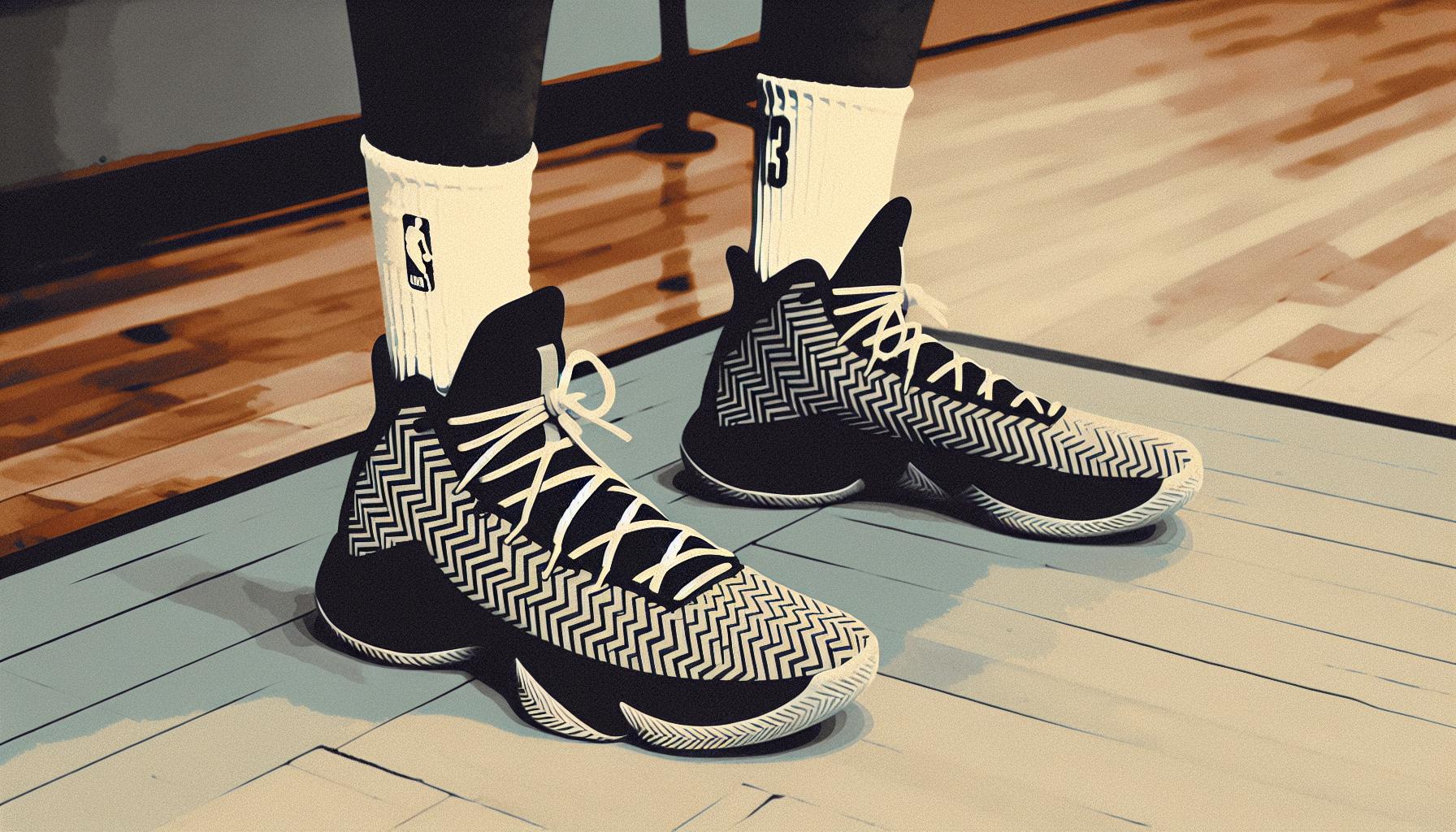Are Basketball Shoes Good for Gym Workouts? Real Insights & Tips
When I first laced up a pair of basketball shoes for my workout, I was skeptical. Could these sneakers, designed for the hardwood, really support me through a high-intensity gym session? It’s a question many of us have pondered as we aim to optimize our fitness routines. Let’s dive into the world of basketball shoes and their place in the gym.
Basketball shoes are engineered for quick movements, ankle support, and cushioning—features that sound beneficial for a variety of workouts. But do they translate well to the weights, the treadmill, and the plyo box? I’ve explored the pros and cons, and I’m here to share my insights. Whether you’re a weekend warrior or a dedicated gym-goer, understanding the suitability of basketball shoes for your workout regimen can make all the difference.
Key Takeaways
- Basketball shoes are designed with features such as quick movement support, ankle stability, and cushioning, which can be beneficial for various gym workouts, offering potential advantages like enhanced traction, additional ankle support, and better impact absorption.
- While basketball shoes offer several benefits for gym use, including improved traction on slippery floors and added support and cushioning for high-impact exercises, they may not suit every type of workout due to their weight, bulkiness, and lack of flexibility.
- Choosing the right basketball shoes for workouts involves considering factors such as traction, ankle support, cushioning, breathability, and the fit and weight of the shoes to ensure they complement rather than hinder your fitness routine.
- Real-world experiences highlight that basketball shoes can significantly enhance gym workouts by providing stability, support, and comfort, but the suitability can vary based on the design of the shoe and the specific needs of the individual’s training regimen.
Exploring the Design of Basketball Shoes

When I first considered using basketball shoes for my gym workouts, I was curious about what made them different from typical training or running shoes. Delving into their design, I discovered a few key features that are tailored for the demands of basketball but could potentially benefit a gym routine.
Firstly, basketball shoes are designed for Quick Movements. They often have a herringbone pattern on the sole that provides excellent traction. This is essential for basketball players who need to stop, start, and change directions quickly. In a gym setting, this traction could be just as beneficial, especially during agility workouts or when using equipment that requires a firm stance.
Another vital feature is Ankle Support. Basketball shoes tend to have a higher cut that wraps around the ankle, offering additional support. This design element is crucial when making fast, multi-directional movements that could otherwise lead to ankle injuries. I found this aspect particularly reassuring during weightlifting, as it helped stabilize my base when performing squats or deadlifts.
Cushioning is also a standout feature in basketball shoes. They are equipped with ample cushioning to absorb the impact when players jump and land. This level of cushioning varies across different models and can be a game-changer in the gym, especially during high-impact exercises or even when running on the treadmill. The cushioning not only protects the joints from the shock of hard impacts but also provides a comfortable base for prolonged workouts.
It’s clear that the design of basketball shoes focuses on supporting dynamic movements, stability, and impact protection. These features, built to handle the hardwood’s rigors, also offer potential benefits for various gym activities. However, the suitability of basketball shoes for specific workouts might depend on their design specifics and the individual’s training needs.
Benefits of Using Basketball Shoes for Working Out

When I started integrating basketball shoes into my workout routine, I noticed several immediate benefits that genuinely surprised me. Firstly, traction was a game-changer. Gym floors, much like basketball courts, can be slippery, especially if you’re pushing hard during a workout. The herringbone pattern found on many basketball shoes offers unparalleled grip, allowing for quick, confident movements without the fear of slipping. This feature alone has made a massive difference in my plyometric exercises and agility drills.
Another significant benefit I’ve experienced is ankle support. Basketball shoes are designed to offer protection during sudden twists and turns, which are common in the game. This level of support is also incredibly beneficial in the gym, especially when performing exercises that require lateral movements or rapid direction changes. It’s provided me with a sense of stability that I hadn’t found in other types of athletic footwear, ensuring I can focus on my form and performance without worrying about potential ankle injuries.
Lastly, the cushioning in basketball shoes is not to be overlooked. The impact from jumping and running can take its toll on your joints over time. The cushioning in basketball shoes is engineered to absorb shock, making them an excellent choice for high-impact workouts. This has not only enhanced my comfort during workouts but has also helped in reducing post-exercise soreness, allowing me to train more frequently and with higher intensity.
While basketball shoes are designed with the hardwood in mind, their features are surprisingly suited for various gym activities. From the enhanced traction for stability in quick movements to the cushioning that protects against impact, I’ve found that basketball shoes can be a great asset in my fitness arsenal. It’s important to remember that everyone’s feet and training needs are different, so what works for me might not work for everyone. However, the potential benefits they offer make basketball shoes worth considering for your next gym shoe.
Drawbacks of Using Basketball Shoes for Working Out

While the perks of using basketball shoes for workouts are clear, it’s only fair to examine the potential downsides. Not all workout activities benefit from the design of basketball shoes, and in some cases, they might even hinder performance or comfort.
Weight and Bulkiness: Basketball shoes are often heavier and bulkier than standard workout or running shoes. This isn’t a deal-breaker for everyone, but for activities requiring a lot of foot movement or endurance running, the extra weight can be a drawback. The bulkiness can also reduce the feel for certain activities, like using stationary bikes or some types of strength training equipment.
Flexibility: Another area where basketball shoes might fall short is in flexibility. They’re designed to protect and support during the dynamic movements of basketball, which means they can be quite rigid. This rigidity can limit the natural foot movement for exercises that benefit from a more flexible sole, like certain types of agility training or Pilates.
Breathability: I’ve noticed that some basketball shoes can lack sufficient breathability due to their robust construction intended to offer support and durability. This attribute could lead to discomfort during long workout sessions or in warmer environments, where keeping the feet cool and dry is essential for comfort and hygiene.
In considering whether basketball shoes are good for working out, it’s crucial to weigh these drawbacks against the benefits. Depending on the specific types of workouts I plan to do, the balance may tilt in favor or against using basketball shoes. Remembering that no shoe fits all situations helps keep my expectations in check, ensuring I choose the right gear for my fitness journey.
Tips for Choosing the Right Basketball Shoes for Workouts

When it comes to selecting basketball shoes for my workouts, I’ve learned that not all sneakers are created equal. Over the years, I’ve gathered some key tips that help me choose the perfect pair, ensuring that the benefits outweigh any potential drawbacks.
First off, traction is crucial. I always look for shoes with a strong grip to prevent any slipping during exercises. This is especially important if I’m using them on different surfaces, both indoors and outdoors. Basketball shoes with excellent traction offer stability and safety, two aspects I can’t compromise on during intense sessions.
Another aspect I consider is the ankle support. Given the dynamic movements in workouts, from jumping to quick directional changes, the right level of ankle support is a must. High-tops are usually my go-to for this reason. Yet, I’ve learned it’s important to strike a balance. Too much support can restrict movement, so I look for shoes that provide flexibility too.
Cushioning is the next box to tick. Adequate cushioning absorbs impact, reducing the strain on my joints. I’ve found that models with foam or air-based cushioning systems offer the best comfort without adding unnecessary weight.
However, breathability is equally important. I opt for shoes with mesh or ventilated materials to ensure my feet stay cool and dry. This helps prevent overheating and discomfort during longer workout sessions.
Lastly, I consider the weight and fit of the basketball shoes. Lightweight models are preferable for most workouts as they allow for more natural movement. And when it comes to fit, nothing beats trying them on. I make sure there’s enough room to move my toes but also ensure the shoes are snug enough to prevent any sliding around, which can lead to blisters and discomfort.
By keeping these tips in mind, I’ve been able to find basketball shoes that complement my workout routine, offering the right mix of support, comfort, and flexibility without sacrificing performance.
Real-Life Experiences: Using Basketball Shoes in the Gym

When I first considered using basketball shoes for my gym workouts, I was a bit skeptical. The notion seemed counterintuitive, given the specific design and purpose of basketball shoes. However, my journey into integrating them into my workouts has been eye-opening.
Initially, the traction basketball shoes offer was a game-changer for me. On gym floors that can sometimes be slick, especially around areas where weights are lifted, the grip on my basketball shoes made a world of difference. I found myself able to perform exercises like lunges and squats with improved stability. It’s this traction that has prevented slips and injuries, ensuring I can focus on my form and execution.
Moreover, the ankle support provided by basketball shoes became invaluable during dynamic movements. Whether I was jumping rope or doing plyometric exercises, the support around my ankles helped reduce the fear of sprains or twists. This support didn’t just offer physical protection; it gave me the confidence to push harder in my workouts.
The cushioning in basketball shoes, designed to absorb impact on the court, translated well to the gym environment. High-impact workouts suddenly felt less strenuous on my joints, which was a revelation. The cushioning offered a balance between support and comfort, allowing me to extend my workout duration without discomfort.
Breathability was another factor that pleasantly surprised me. Despite their sturdy build, my basketball shoes were designed with materials that allowed for good air circulation. This meant my feet stayed cooler and more comfortable, even during intense workout sessions.
However, not all basketball shoes are created equal. I learned the importance of considering the weight and fit of the shoe for gym activities. Some models were too bulky for certain exercises, while others fit like a glove and offered the perfect balance for my workout routine. Through trial and error, I found what worked best for me, emphasizing the need for anyone considering this to do thesame.
Conclusion
After putting basketball shoes to the test in the gym, I’m convinced they’re more than just court companions. Their superior traction, ankle support, and cushioning not only enhance performance but also significantly reduce injury risks. While it’s crucial to weigh factors like weight and fit, my journey shows that with a bit of trial and error, finding basketball shoes that elevate your workout is entirely possible. So if you’re on the fence about swapping out your regular trainers, give basketball shoes a shot. You might just be surprised at the difference they make.
Frequently Asked Questions
Can basketball shoes really improve gym workouts?
Yes, basketball shoes can improve gym workouts by providing better traction which ensures stability during exercises like lunges and squats, reducing the risk of slips and injuries.
How do basketball shoes aid in preventing ankle sprains?
Basketball shoes offer excellent ankle support, which is crucial for reducing the risk of sprains during dynamic movements in the gym, aiding in safer and more confident workouts.
Are basketball shoes good for high-impact gym activities?
Yes, the cushioning in basketball shoes is designed for impact absorption, making them suitable for high-impact gym activities by lessening the strain on joints.
Do basketball shoes offer any benefits in terms of breathability?
Basketball shoes are generally designed with breathability in mind, which helps in keeping the feet cool and comfortable during intensive gym sessions.
Is it important to consider the weight and fit of basketball shoes for gym use?
Yes, it is essential to find basketball shoes with the right balance of weight and fit for gym use, as personal comfort and the effectiveness of workouts can significantly depend on these factors.










